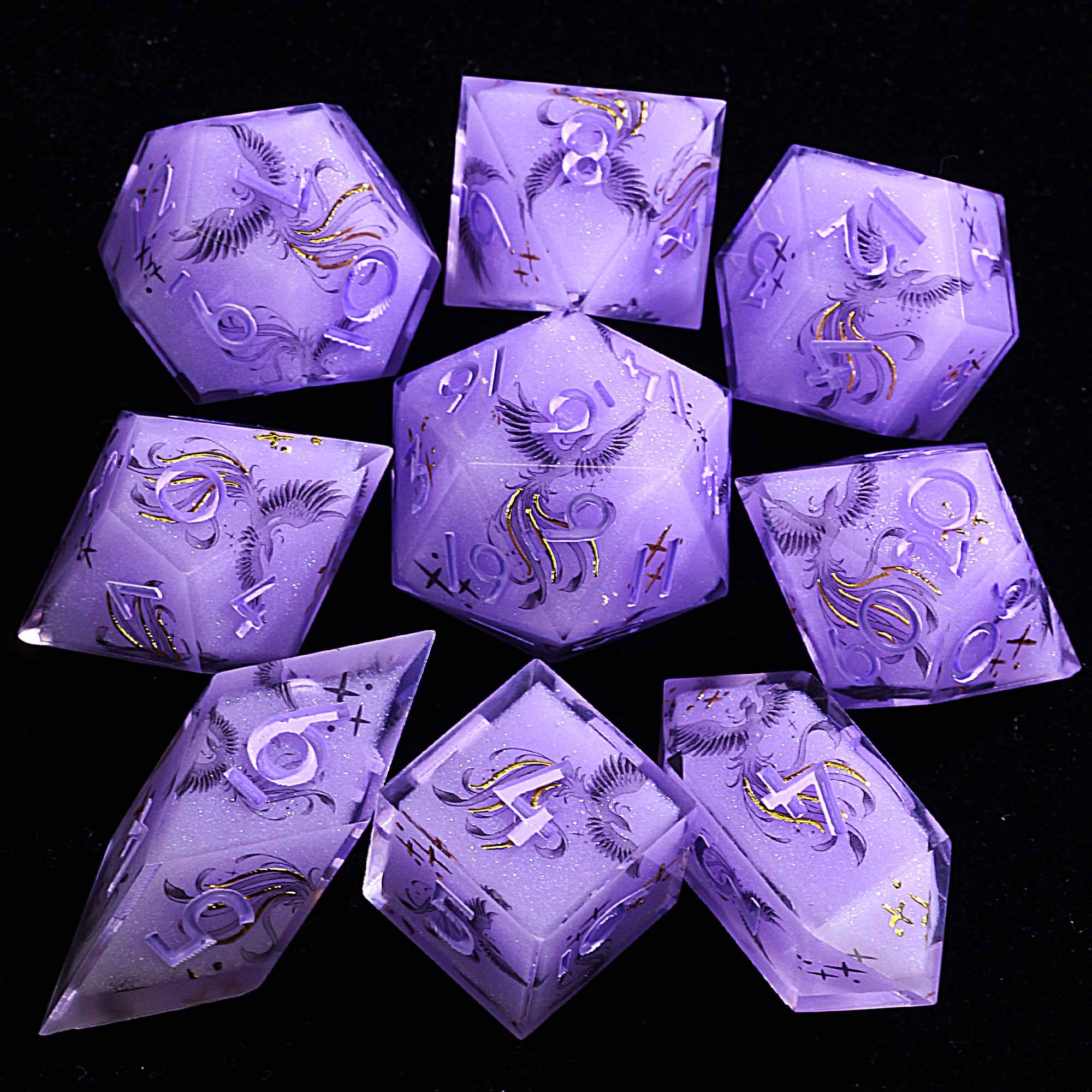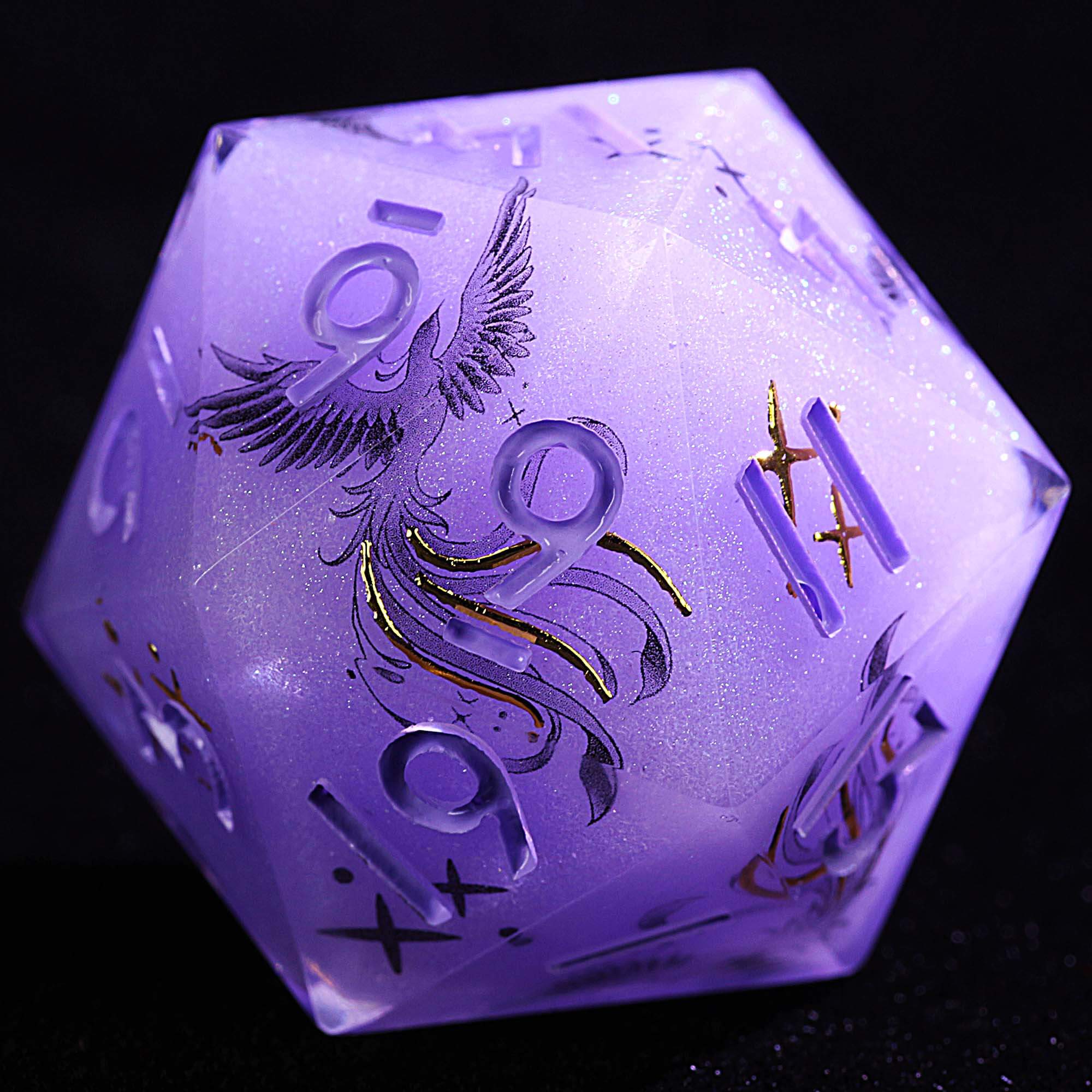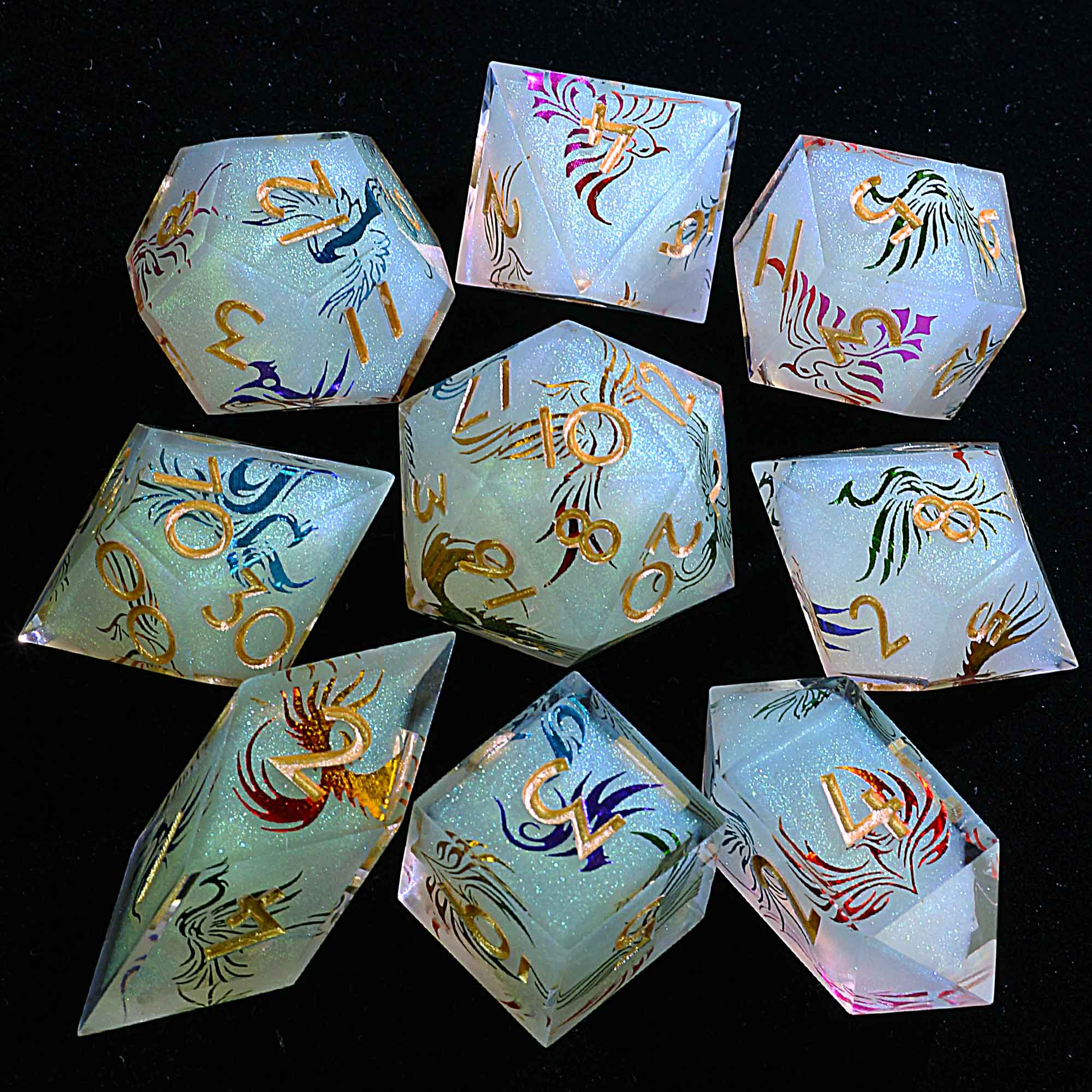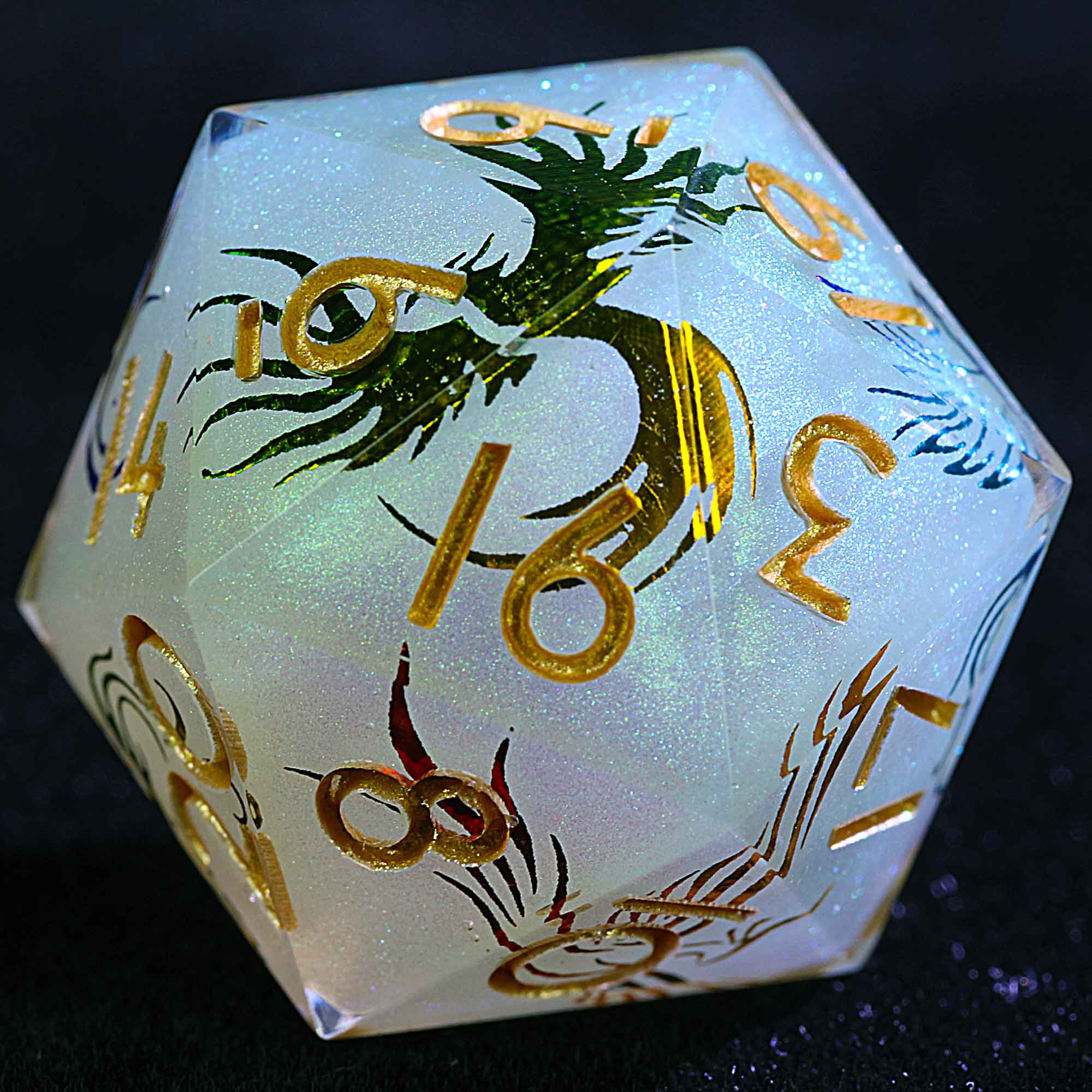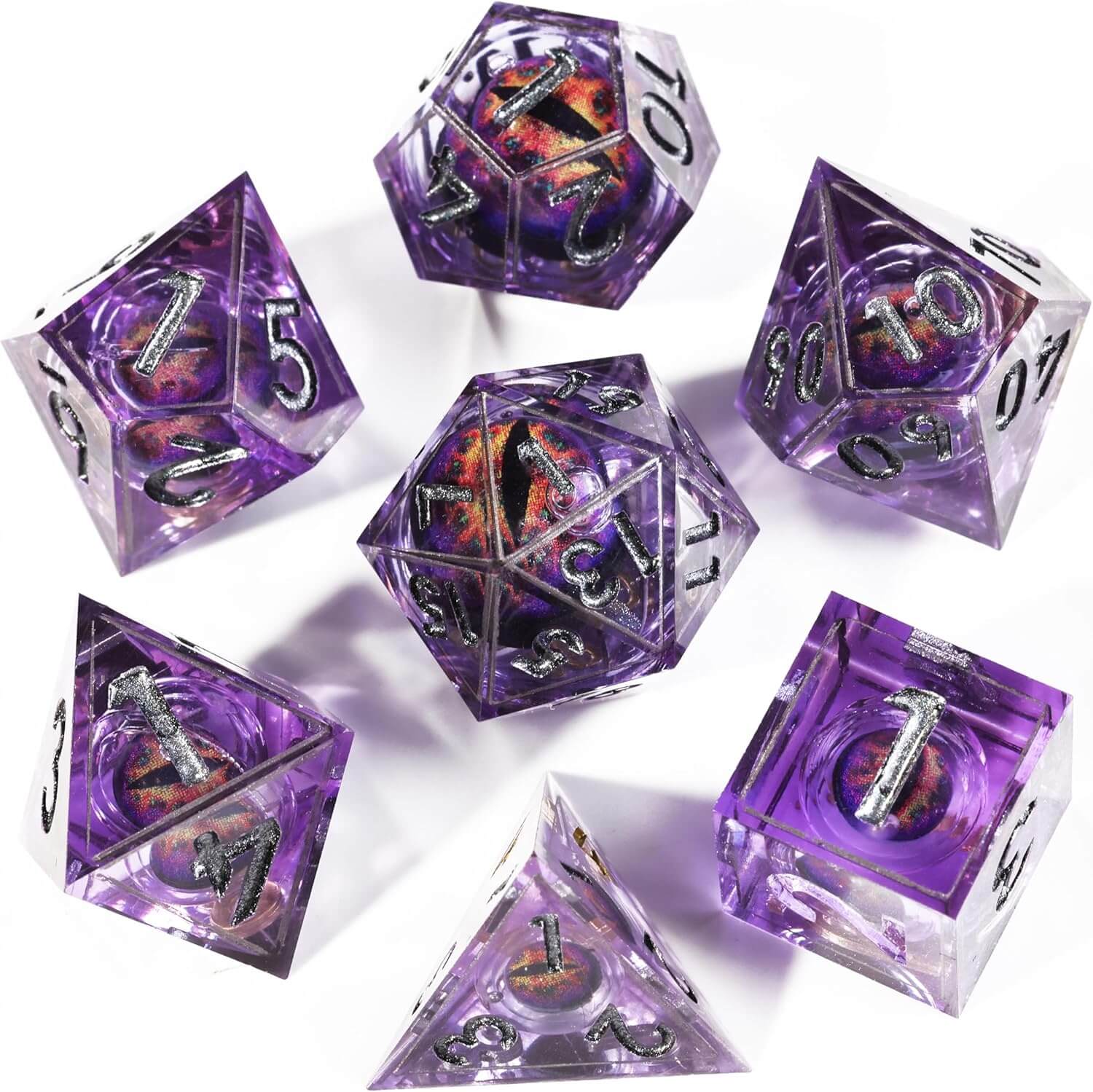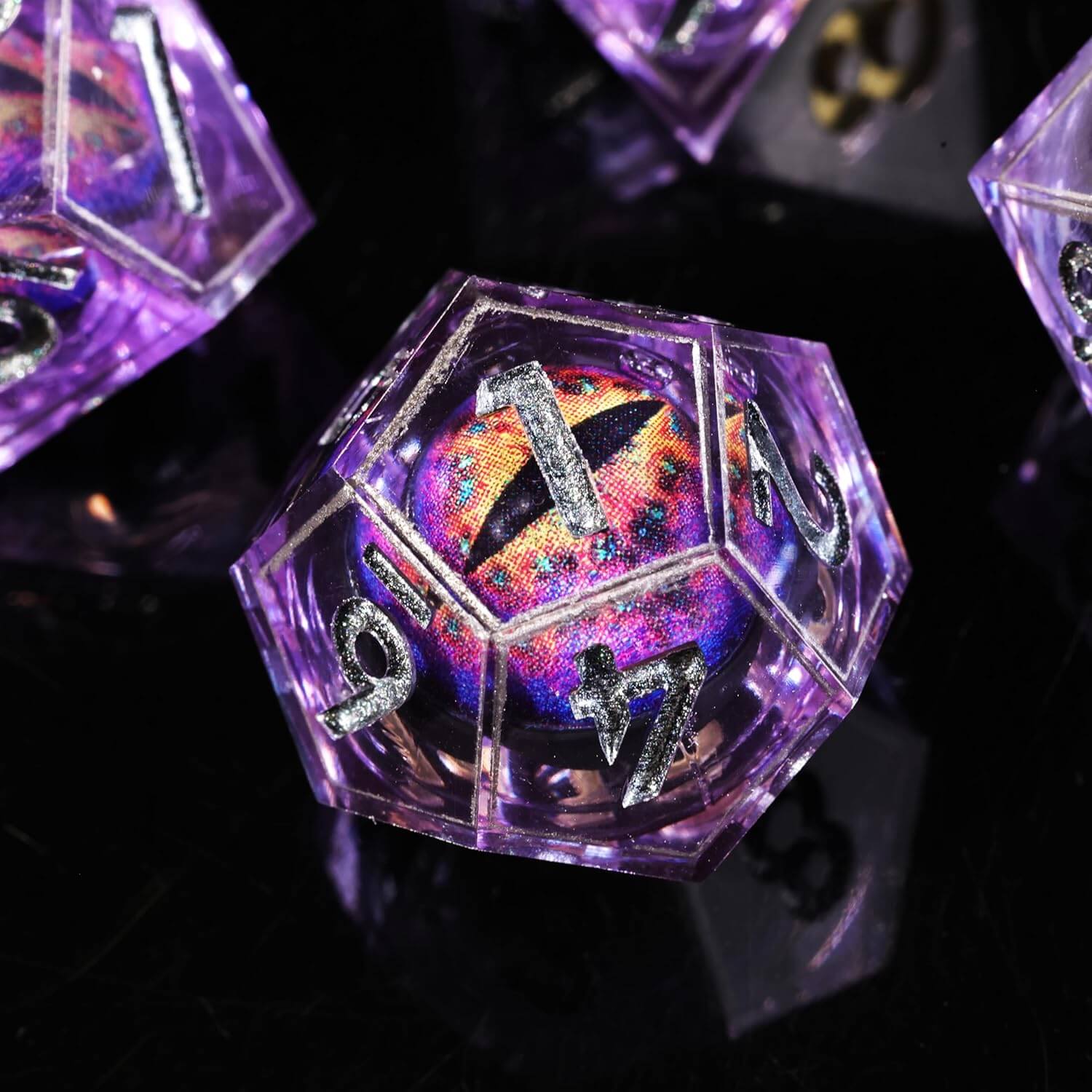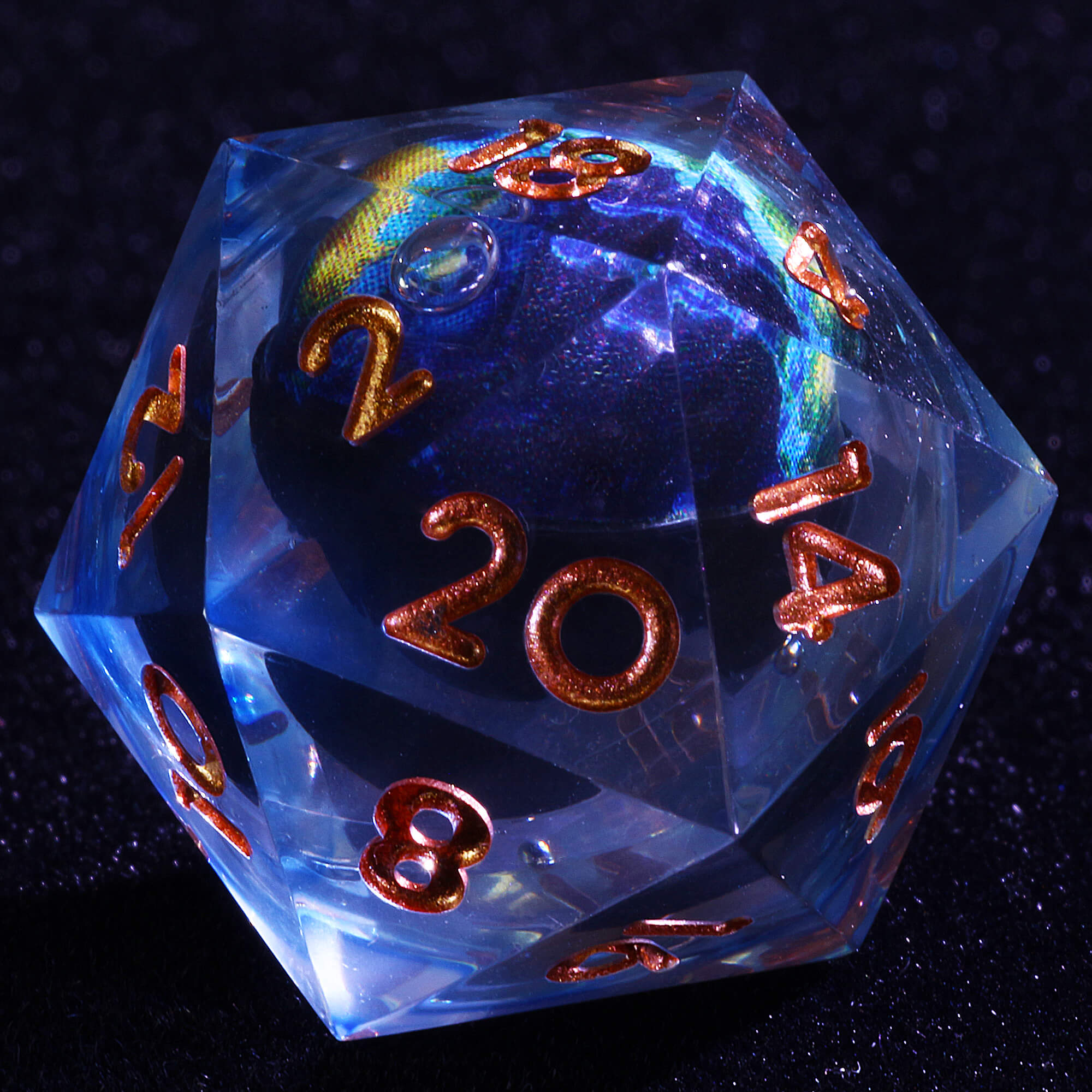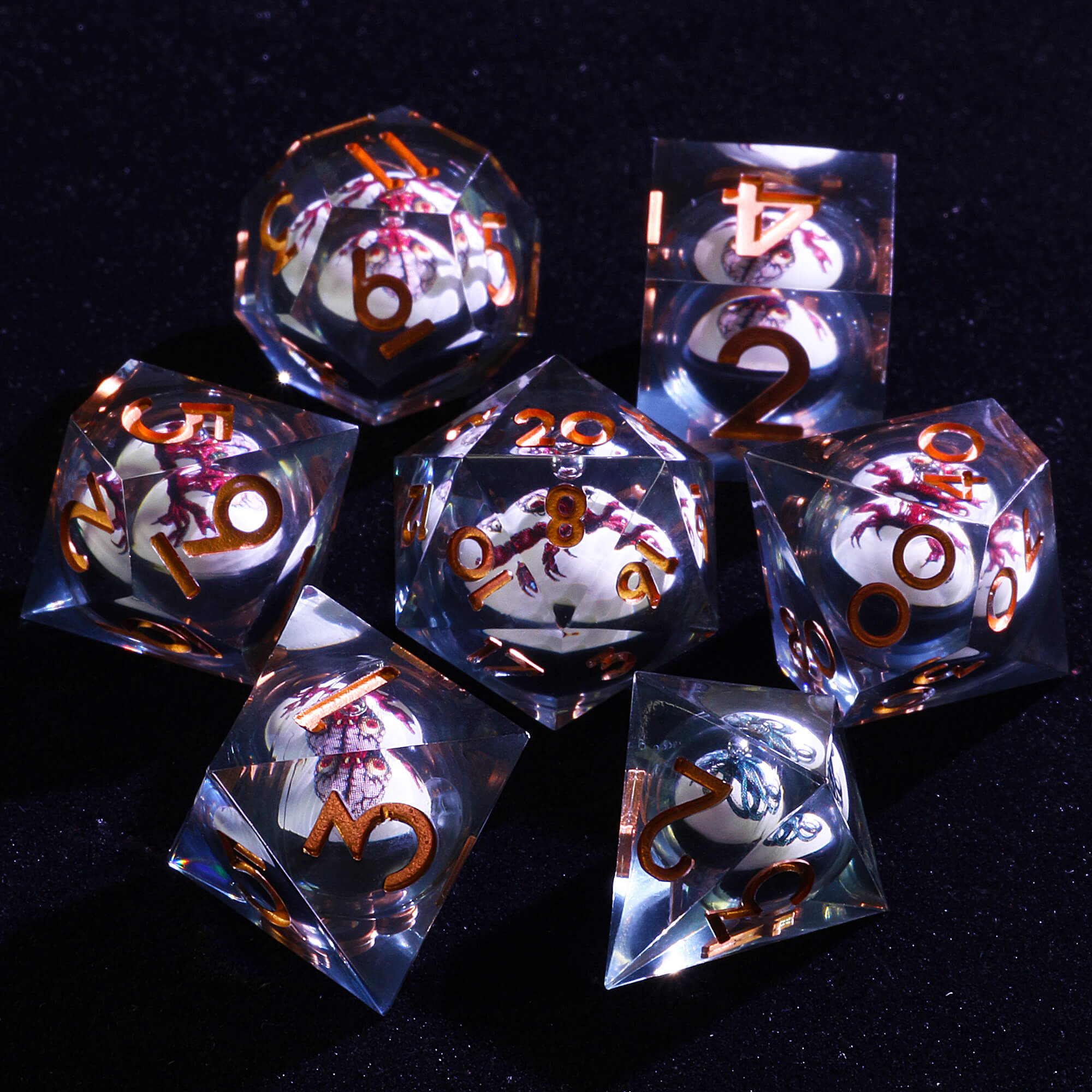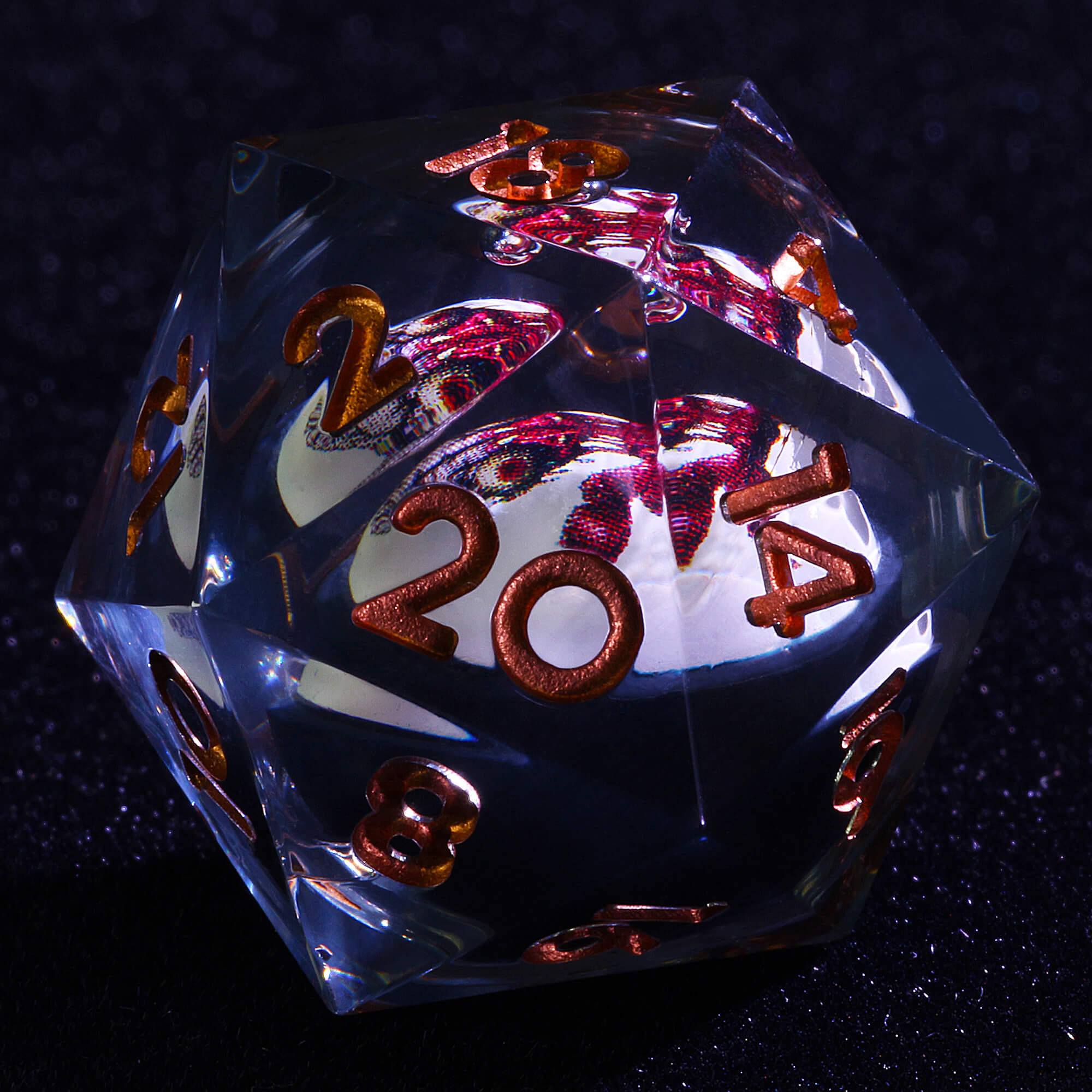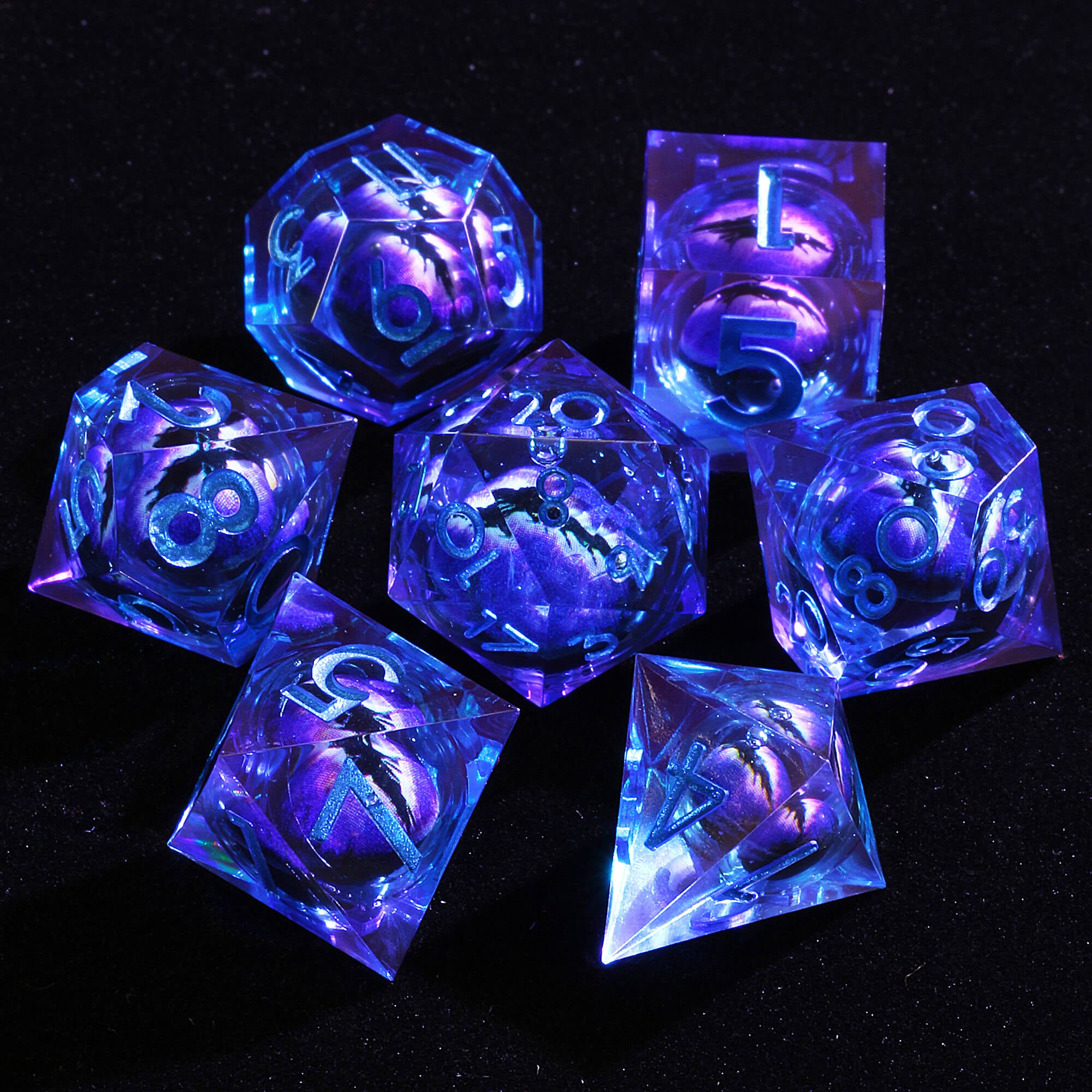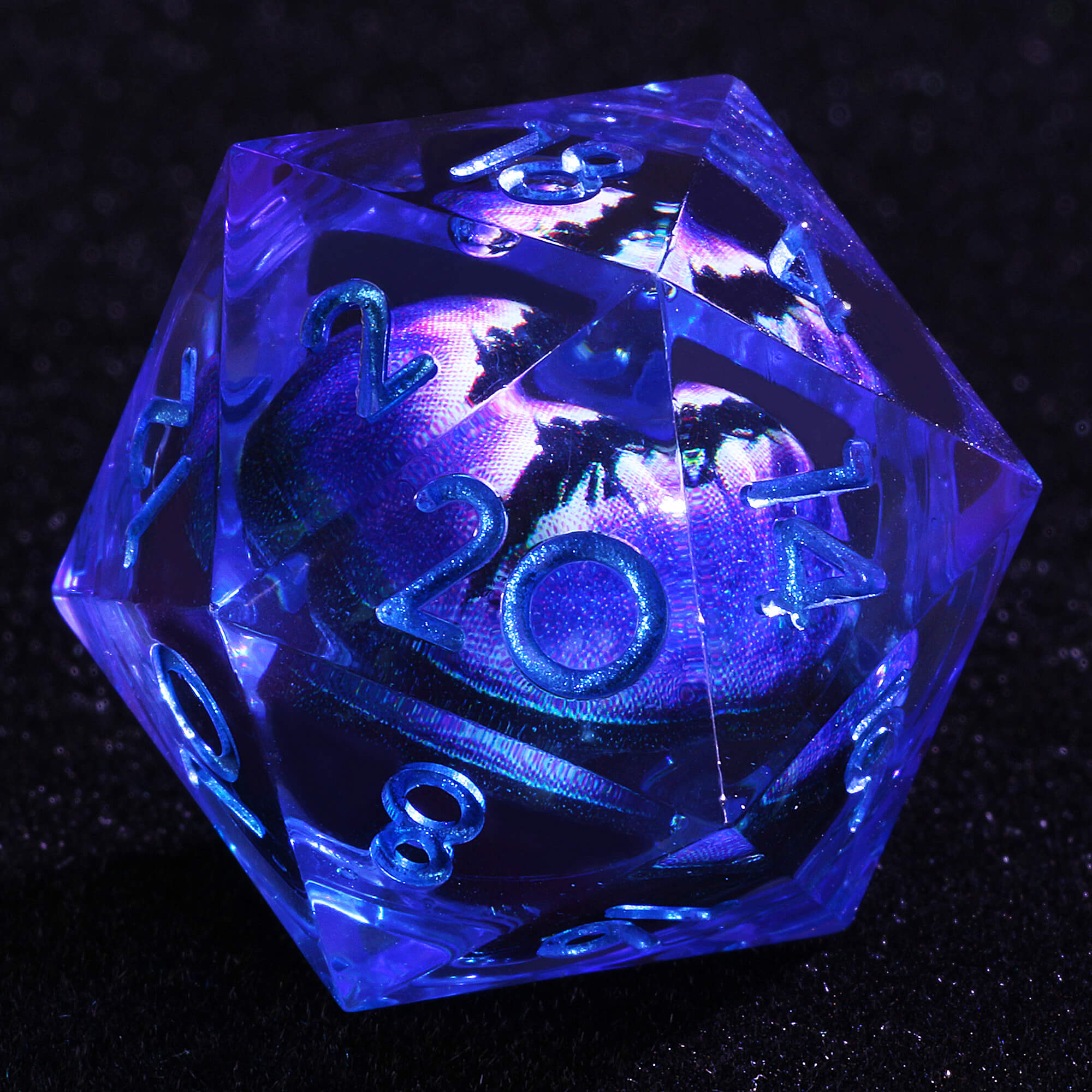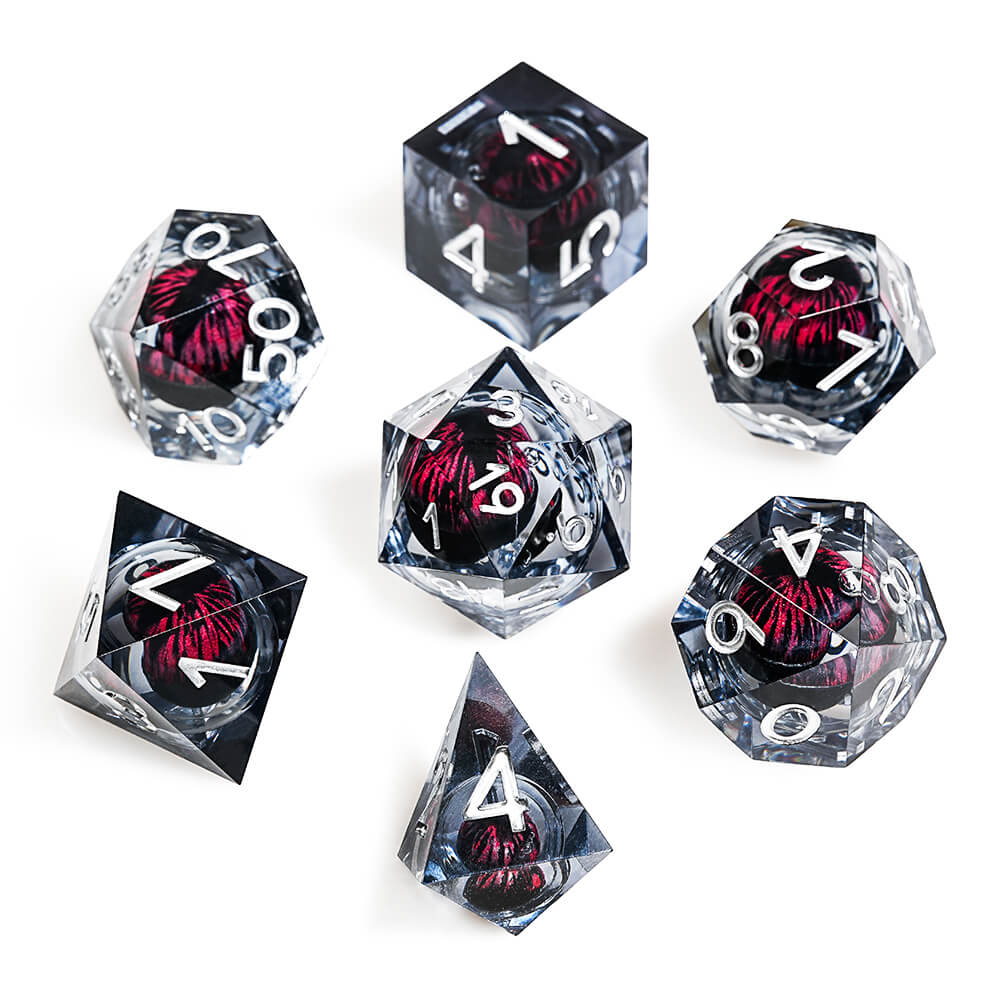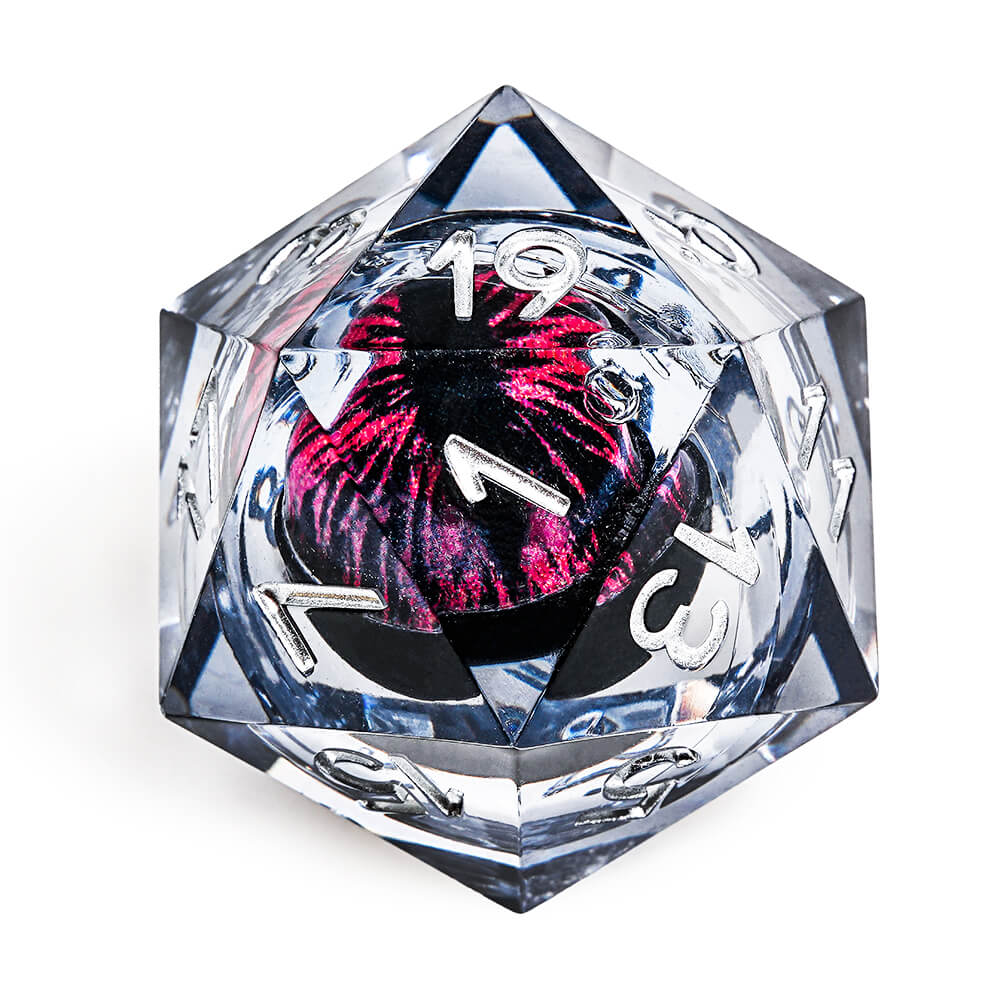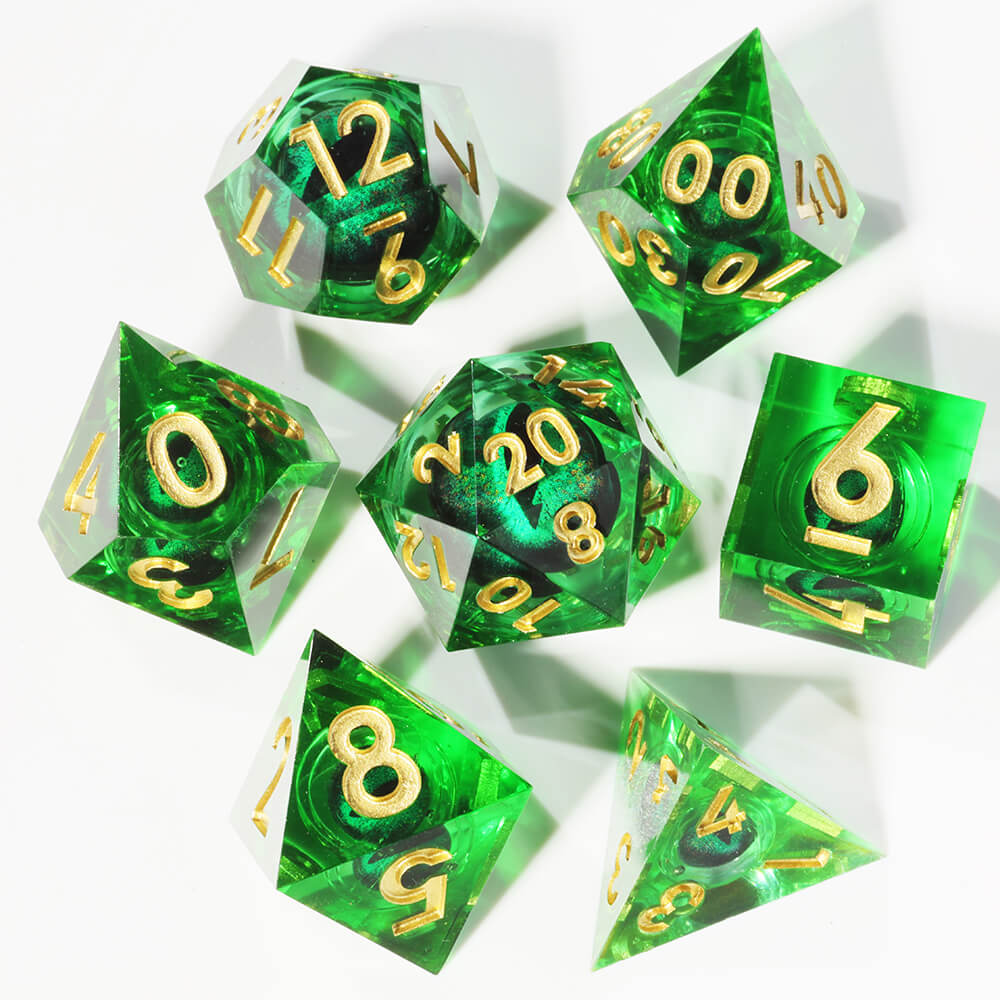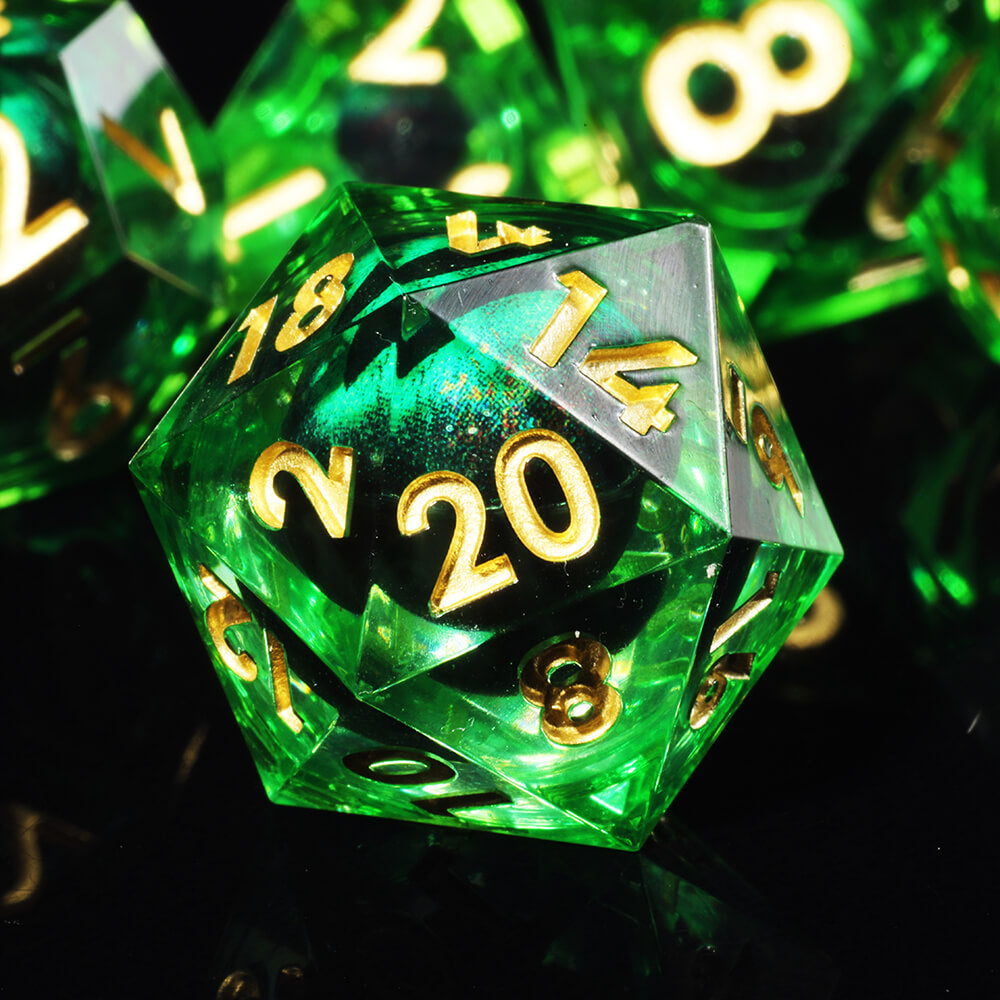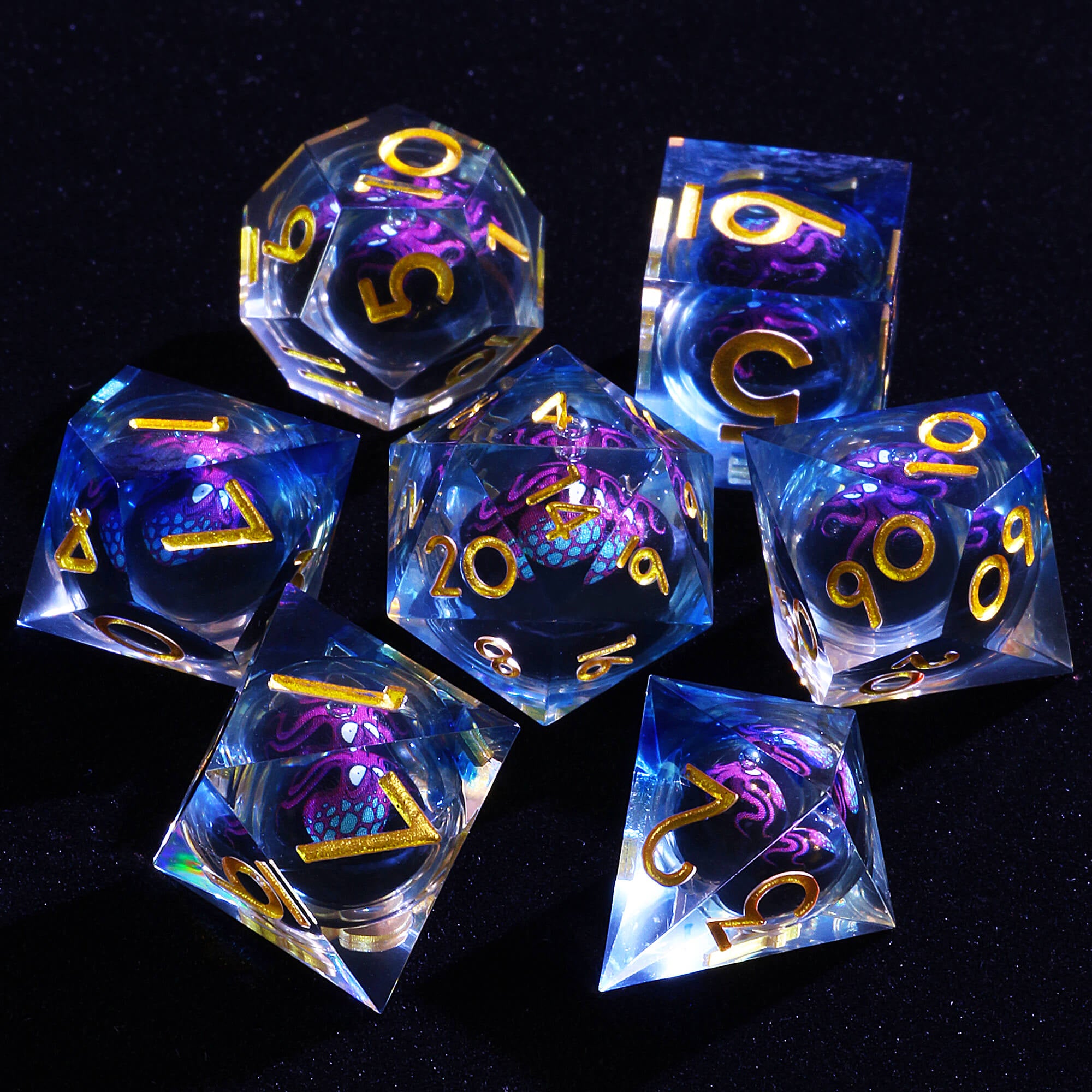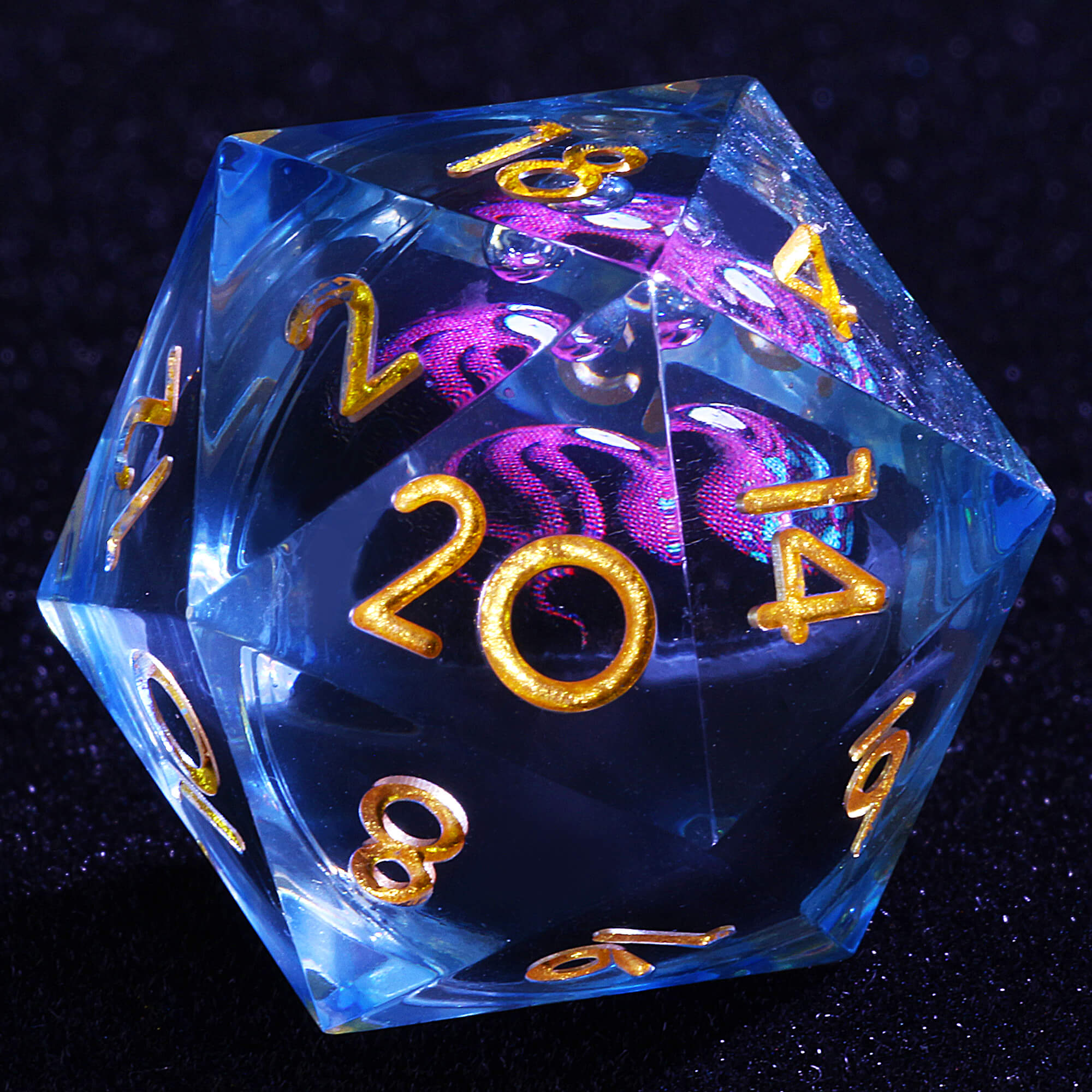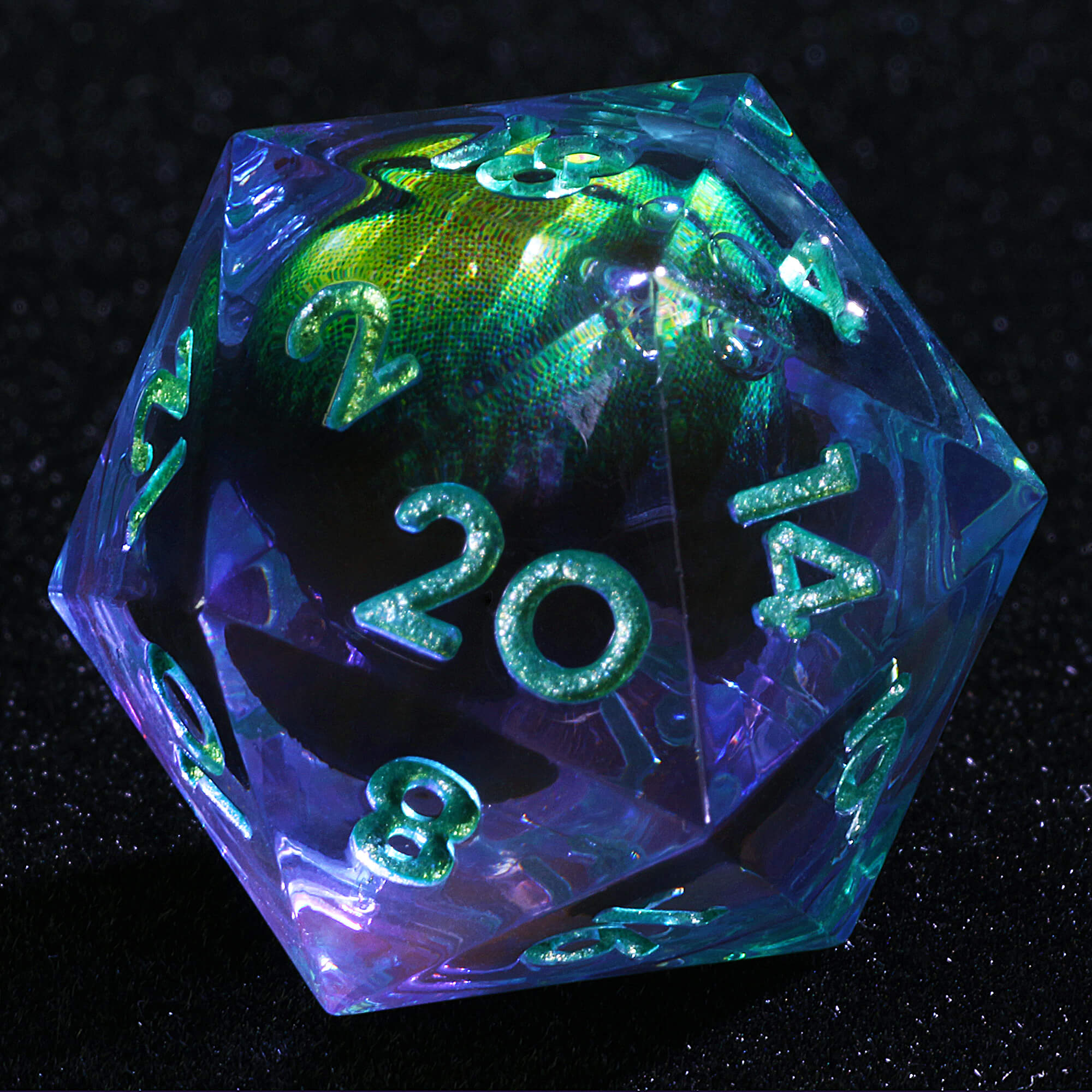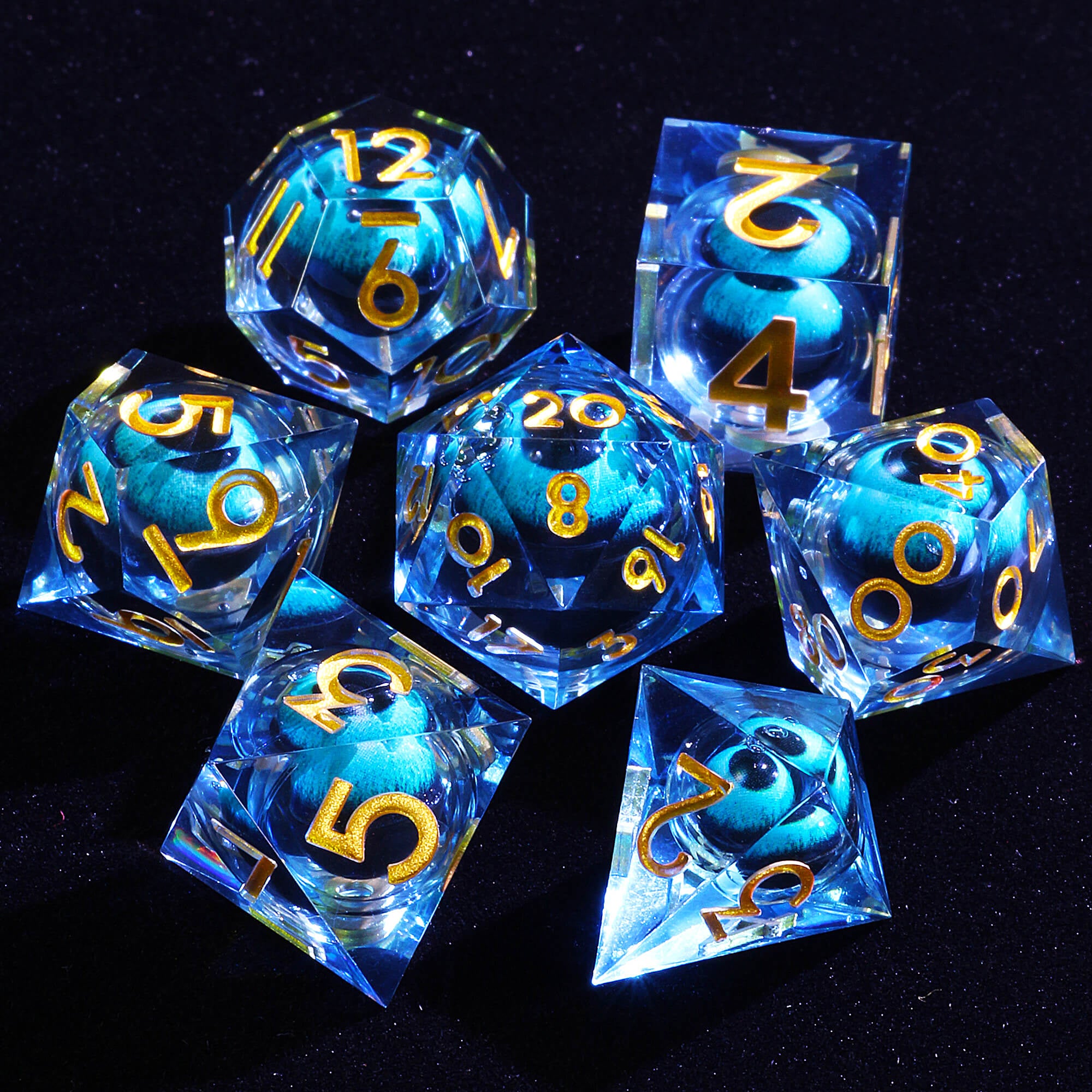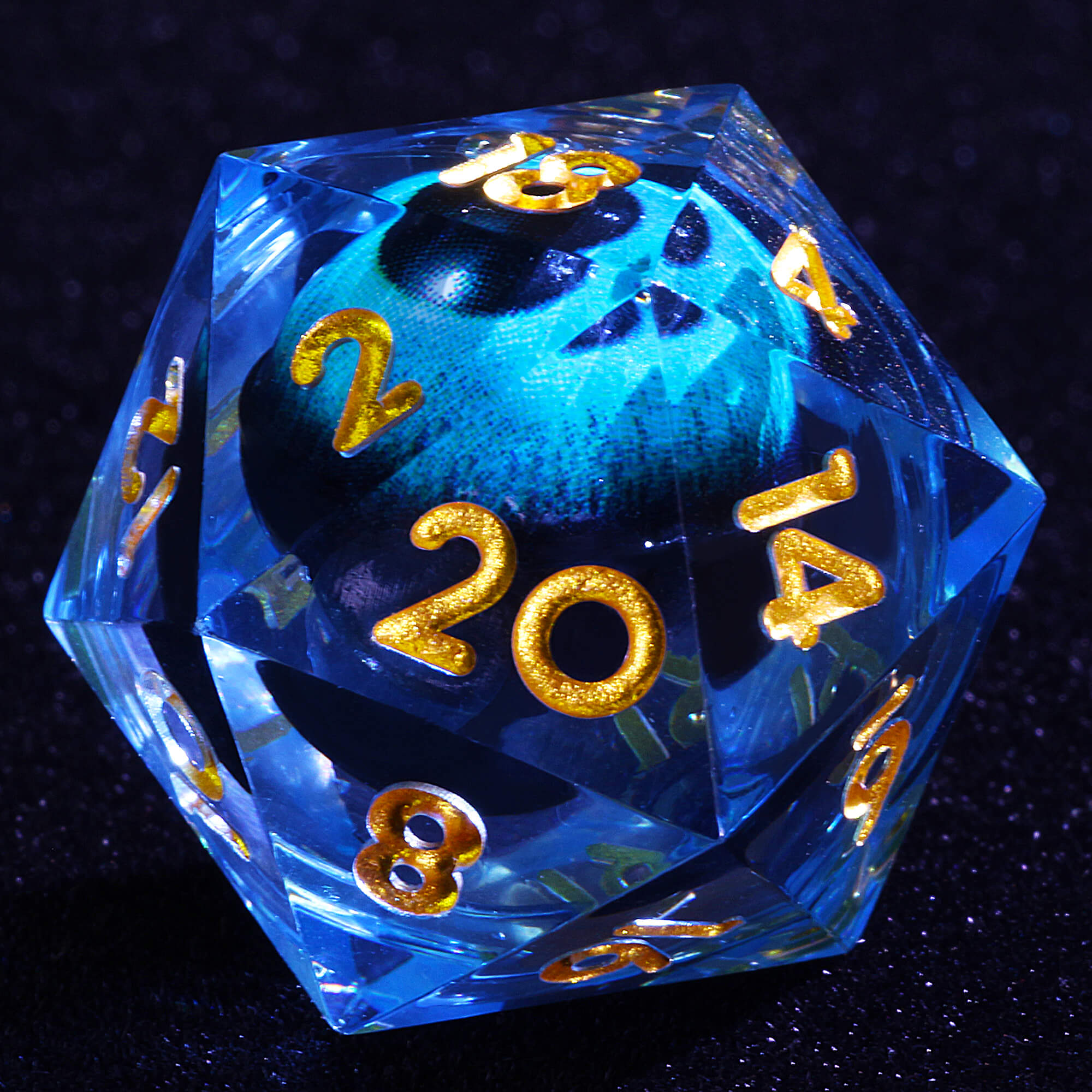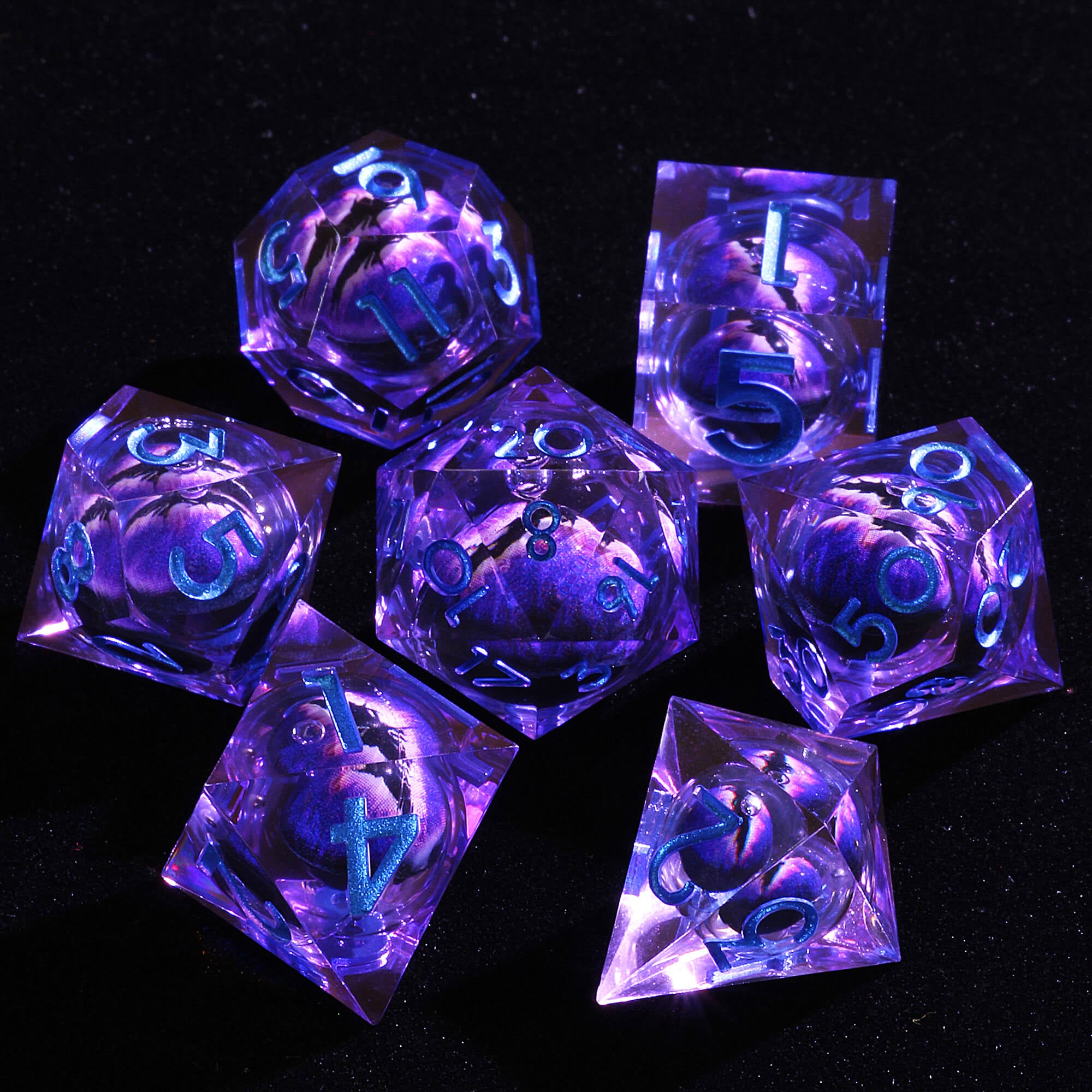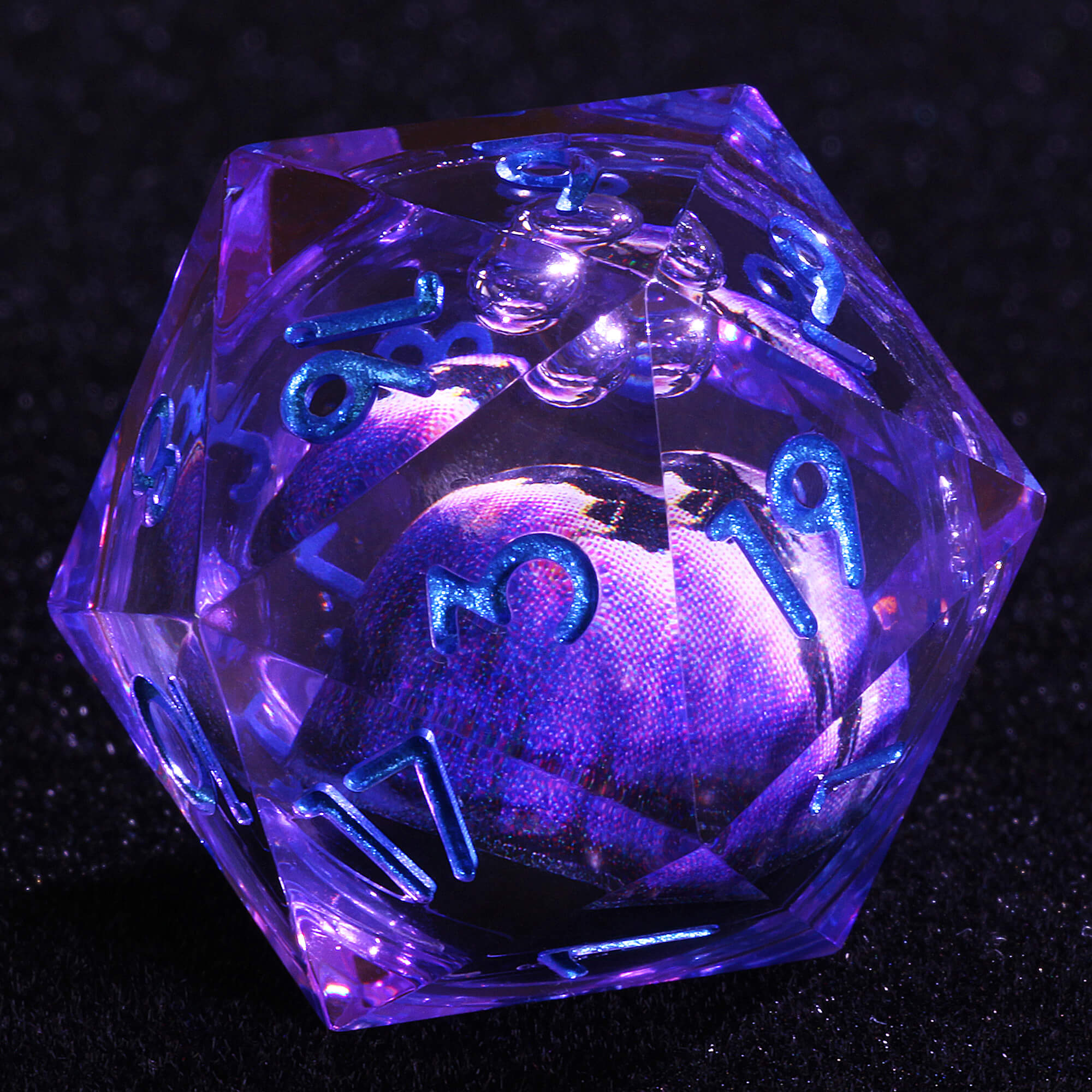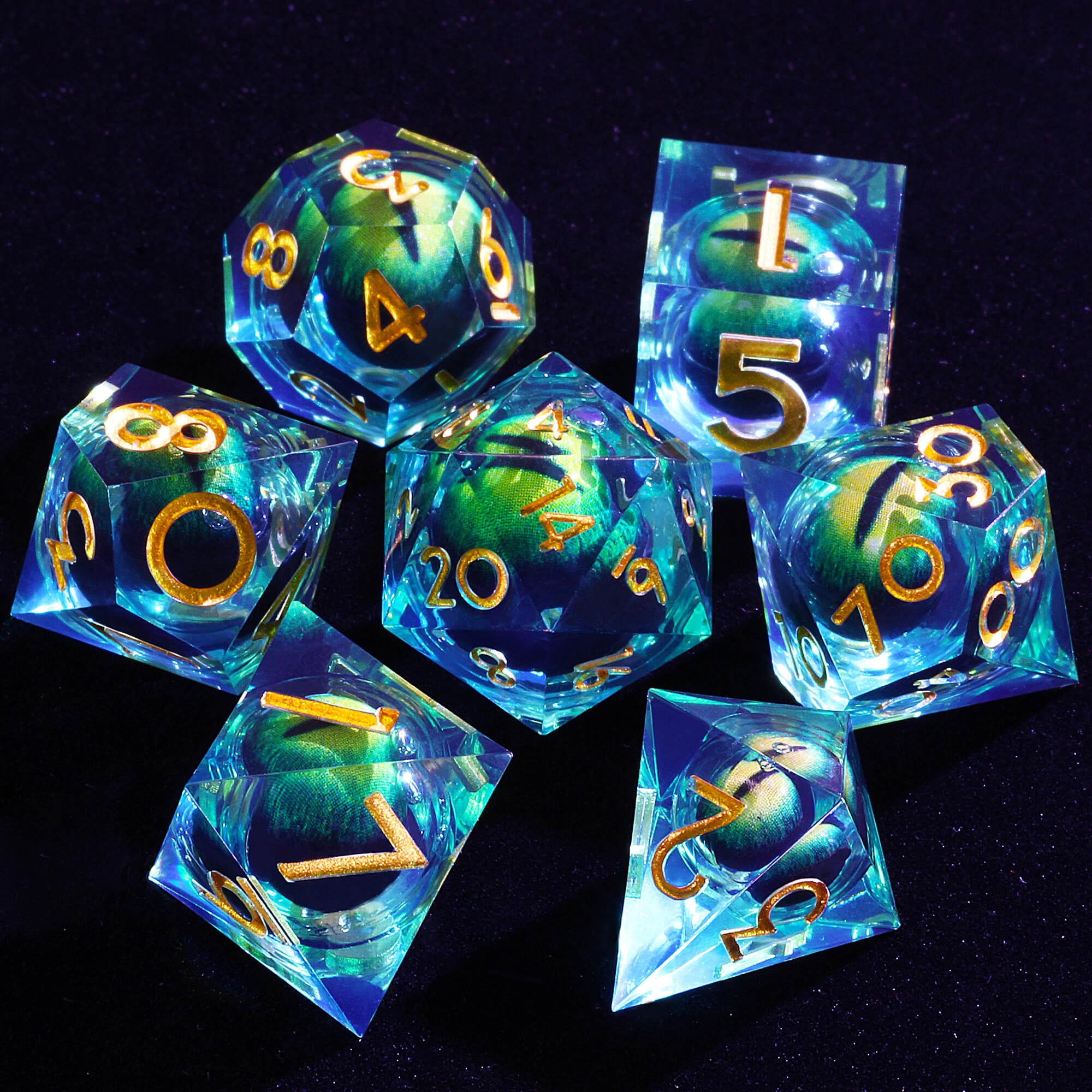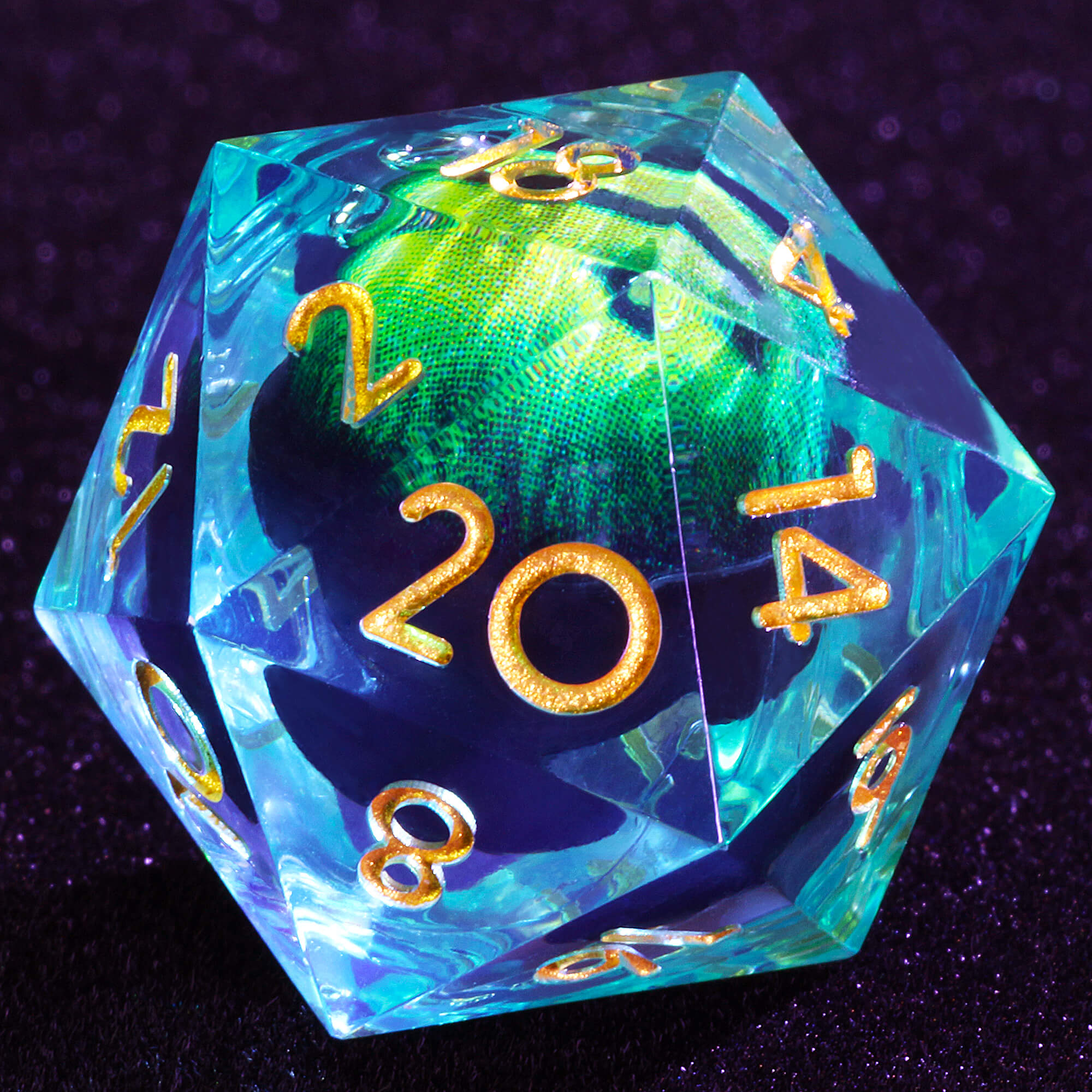Dice are central to tabletop RPGs, providing the randomness and excitement that define gameplay. They are more than just randomizers; they help to drive narratives, determine outcomes, and create a sense of suspense and unpredictability. This blog will explore how dice function in some of the most popular tabletop RPGs, highlighting how they contribute to each game's unique mechanics and storytelling. From Dungeons & Dragons to modern games, discover how these dice sets shape the roleplaying experience.
Dungeons & Dragons (D&D)
Dungeons & Dragons, often regarded as the grandfather of tabletop RPGs, immerses players in a fantasy world of adventure and magic. The game allows players to create detailed characters, explore dungeons, and embark on epic quests in a richly imagined setting filled with dragons, wizards, and mythical creatures.
Dice Used: A variety of dice are used, one dice set per player( including 1 D4, 1 D6, 1 D8, 2 D10, 1 D12, and 1 D20 ).
Role of Dice: In D&D, each type of die has a specific role, contributing to the game's complexity and depth. The D20 is central for most rolls, including attack rolls, saving throws, and skill checks. This die determines whether characters succeed or fail in critical actions. Other dice types, like the D4, D6, D8, D10, and D12, are used to calculate damage, spell effects, and various outcomes. The diversity in dice types adds layers of strategy and unpredictability to the game, enhancing the gameplay's excitement and the storytelling's richness.
Pathfinder
Pathfinder builds on the foundations laid by D&D's 3.5 Edition, offering a highly detailed and customizable fantasy roleplaying experience. Players engage in intricate adventures within a meticulously crafted world, emphasizing deep character development and complex rules.
Dice Used: A variety of dice are used, one dice set per player( including 1 D4, 1 D6, 1 D8, 2 D10, 1 D12, and 1 D20 ).
Role of Dice: Pathfinder employs a dice system similar to D&D, with the D20 being used for attack rolls, skill checks, and saving throws. This die determines success or failure in actions based on the character's abilities and modifiers. The other dice types are used to roll for damage and resolve specific effects of spells and skills. Pathfinder's system emphasizes detailed character customization and tactical decision-making, supported by its comprehensive dice mechanics.
Call of Cthulhu
Call of Cthulhu is a horror RPG that draws on H.P. Lovecraft's cosmic horror themes. Players assume the roles of investigators exploring a world filled with eldritch horrors and forbidden knowledge. The game emphasizes psychological tension and the fragility of human sanity.
Dice Used: Percentile dice (two D10s, one representing tens and the other units).
Role of Dice: In Call of Cthulhu, percentile dice determine the success or failure of actions based on the character's skill levels, which are expressed as percentages. Players roll two D10s to produce a number from 00 to 99 and compare this to their skill level. Rolling equal to or below the skill level signifies success. This system mirrors the game's emphasis on realism and unpredictability, heightening the tension and sense of dread that characterizes the horror genre.
Shadowrun
Shadowrun merges cyberpunk aesthetics with fantasy elements, placing players in a dystopian future where magic and technology coexist. The game focuses on high-stakes heists and the struggles of life in a world dominated by powerful corporations and street-level intrigue.
Dice Used: Multiple six-sided dice (D6), typically a 5-10 dice pool.
Role of Dice: Shadowrun employs a pool of D6s to resolve actions. Players roll multiple dice, counting those that meet or exceed a target number to determine success. This mechanic emphasizes the game's cyberpunk theme by focusing on numerous small successes rather than a single result. The dice pool system supports complex actions and critical decision-making, reflecting the high-tech and magical elements of the game's setting.
Star Wars Roleplaying Game
Set in the expansive Star Wars universe, this RPG allows players to experience the epic adventures of a galaxy far, far away. Players can engage in heroic battles, explore diverse planets, and interact with iconic characters from the franchise.
Dice Used: Custom dice with symbols, including Ability Dice and Difficulty Dice.
Role of Dice: The Star Wars Roleplaying Game uses custom dice with unique symbols rather than numbers. These symbols represent various aspects of gameplay, such as success, failure, and advantages or setbacks. The dice provide narrative outcomes that enhance the cinematic and storytelling elements of the game. This system allows for a rich, story-driven experience that mirrors the dynamic and epic nature of the Star Wars universe.
Fiasco
Fiasco is inspired by the darkly comedic films of the Coen Brothers. It focuses on characters whose ambitious plans go hilariously or tragically wrong. The game is driven by collaborative storytelling and creating dramatic situations.
Dice Used: Six-sided dice (D6), typically used in 6-10 dice sets.
Role of Dice: Fiasco uses D6s to generate story elements, such as relationships, locations, and situations. The dice are rolled to determine the nature of these elements, influencing the narrative direction and outcomes. The dice system supports the game's emphasis on character-driven stories and chaotic events, fostering engaging and unpredictable narratives.
GURPS (Generic Universal RolePlaying System)
GURPS is a flexible RPG system designed to handle various genres and settings, from historical and contemporary to futuristic and fantastical. The system allows players to create characters and scenarios in virtually any setting.
Dice Used: Six-sided dice (D6), with players typically rolling 3-6 dice per action.
Role of Dice: GURPS uses multiple D6s to resolve actions, with the number of dice rolled depending on the character's skills and the task's difficulty. Players roll the dice to determine success or failure based on the sum of their rolls compared to a target number. This approach supports various genres and settings, making the system adaptable and versatile.
Warhammer Fantasy Roleplay
Set in the dark and perilous world of Warhammer Fantasy, this RPG challenges players to survive in a grim environment filled with danger and political intrigue. The game emphasizes a harsh and unforgiving world where every decision matters.
Dice Used: Ten-sided dice (D10) and six-sided dice (D6).
Role of Dice: Warhammer Fantasy Roleplay uses D10s for critical rolls, such as determining success or failure in combat and skill checks. D6s are used for rolling damage and various effects. This dual-dice system supports the game's dark and dangerous tone, providing a detailed and immersive experience.
Legend of the Five Rings
Legend of the Five Rings is set in a fictional version of feudal Japan, where players explore themes of honor, duty, and conflict. The game's rich setting is inspired by Japanese mythology and samurai culture.
Dice Used: Custom dice, including Ring Dice with symbols.
Role of Dice: The custom Ring Dice in Legend of the Five Rings features symbols representing different aspects of gameplay, such as success, opportunity, and challenges. The dice system emphasizes thematic elements like honor and conflict, supporting the game's focus on narrative and character-driven stories.
Dungeon World
Dungeon World is a narrative-driven RPG set in a classic fantasy setting. It emphasizes player choice and storytelling and focuses on collaborative play and dynamic adventures, allowing players to shape the story.
Dice Used: Six-sided dice (D6), with players typically rolling 1-2 dice per action.
Role of Dice: Dungeon World uses D6s to resolve actions, with players rolling a single die to determine the outcome. The results influence the narrative, supporting the game's storytelling and emphasis on player agency. The simple dice mechanics facilitate a flexible and engaging gameplay experience.
The Dark Eye
The Dark Eye is a well-known German RPG set in the fantasy world of Aventuria. The game is celebrated for its detailed setting and complex rules, providing a deep, immersive roleplaying experience.
Dice Used: Twenty-sided dice (D20) and six-sided dice (D6).
Role of Dice: The Dark Eye combines D20s and D6s to handle different aspects of gameplay. D20s are used for combat and skill checks, while D6s manage damage and other effects. This combination adds depth to the game's fantasy elements, supporting a detailed and multifaceted system.
Cyberpunk 2020
Cyberpunk 2020 is set in a dystopian future where players engage in high-tech heists and navigate a world of corporate intrigue and societal decay. The game explores technology, rebellion, and survival themes in a gritty setting.
Dice Used: Multiple six-sided dice (D6), typically a 6-10 dice pool.
Role of Dice: Cyberpunk 2020 uses a pool of D6s to resolve actions. Players roll multiple dice and count those that meet or exceed a target number to determine success. This system fits the game's fast-paced, high-stakes environment, emphasizing the need for quick and decisive actions.
Torg Eternity
Torg Eternity is set in a multiverse where different realities collide, blending genres and settings. The game allows players to experience various scenarios, from heroic fantasy to sci-fi adventures.
Dice Used: The primary dice used in Torg Eternity are a twenty-sided die (D20) and six-sided dice (D6). Players usually roll a D20 for actions and use D6s to determine additional effects or bonuses.
Role of Dice: The D20 in Torg Eternity is central to resolving actions. At the same time, the D6s are used to calculate extra effects, such as bonus damage or particular outcomes. The dice system is integral to managing the game's diverse scenarios, allowing for varied and dynamic gameplay that fits the multiverse setting.
Hollow Earth Expedition
Hollow Earth Expedition takes players to a hidden world beneath the Earth's surface, filled with ancient mysteries and lost civilizations. The game emphasizes exploration and adventure in a fantastical setting.
Dice Used: Custom Fate Dice with Symbols.
Role of Dice: The custom Fate Dice in Hollow Earth Expedition features symbols that determine the success or failure of actions and the narrative direction. The dice system supports the game's focus on exploration and storytelling, enhancing the sense of discovery and adventure.
Rifts
Rifts is a genre-blending RPG where science fiction, fantasy, horror, and cyberpunk elements converge. Players navigate a world where dimensional rifts allow various creatures and technologies to interact.
Dice Used: Rifts primarily uses a twenty-sided die (D20) for combat and skill checks and a six-sided die (D6) for damage and other secondary rolls. Depending on context, players will typically use 1 D20 and 1 D6 per action.
Role of Dice: In Rifts, the D20 is crucial for determining the success of attacks, skill checks, and other critical actions. The D6 is used for rolling damage and calculating other effects. This dual-dice system manages the game's complex mechanics and enhances its diverse, genre-blending narrative.
Coyote & Crow
Set in an alternate future where Indigenous cultures have advanced technology, Coyote & Crow emphasizes rich storytelling and cultural depth. The game explores themes of heritage and modernity in a speculative setting.
Dice Used: Coyote & Crow uses twelve-sided dice (D12) for resolving actions. The game employs a pool of D12s, with players rolling multiple dice depending on their character's abilities and the task's difficulty.
Role of Dice: In Coyote & Crow, the D12 is the primary die used to determine success or failure in actions. Players roll multiple D12s, counting those that meet or exceed a target number to gauge success. This system reflects the game's emphasis on storytelling and character development, providing a unique and thematic dice mechanic that enhances the narrative experience.
A Game of Thrones
A Game of Thrones RPG immerses players in Westeros's intricate and treacherous world, based on George R.R. Martin's famous fantasy series. The game allows players to explore the political intrigue, battles, and complex characters of the Seven Kingdoms.
Dice Used: A Game of Thrones RPG primarily uses six-sided dice (D6) for resolving actions. Players roll multiple D6s based on their character's abilities and the task's difficulty.
Role of Dice: In A Game of Thrones RPG, players roll pools of D6s to determine the success or failure of actions. The number of D6s rolled corresponds to the character's skill level. At the same time, the difficulty of the task dictates the number of successes needed. This dice mechanic mirrors Westeros's complex and often unpredictable nature, where strategy, alliances, and luck all play crucial roles in determining outcomes. The system emphasizes the narrative depth and intricate decision-making that defines the game's experience.
Blades in the Dark
Blades in the Dark is set in a gritty, industrial fantasy world where players engage in criminal endeavors and high-stakes heists. The game emphasizes narrative and player choice, allowing for dynamic and unpredictable gameplay.
Dice Used: Six-sided dice (D6), with players rolling multiple dice per action.
Role of Dice: Blades in the Dark uses D6s to determine success and consequences. Players roll multiple dice, with the results influencing the narrative and the outcomes of their actions. This system supports the game's focus on narrative-driven play and high-stakes scenarios, enhancing the immersive experience.
Conclusion: Dice are fundamental to the fabric of tabletop RPGs, shaping gameplay and storytelling in diverse ways. From the versatile dice of Dungeons & Dragons to the custom symbols of modern RPGs like Star Wars Roleplaying and Blades in the Dark, TRPGs use dice to enhance its unique experience. Players can better appreciate their intricate role in creating memorable and engaging roleplaying adventures by understanding how different games incorporate dice into their mechanics.

